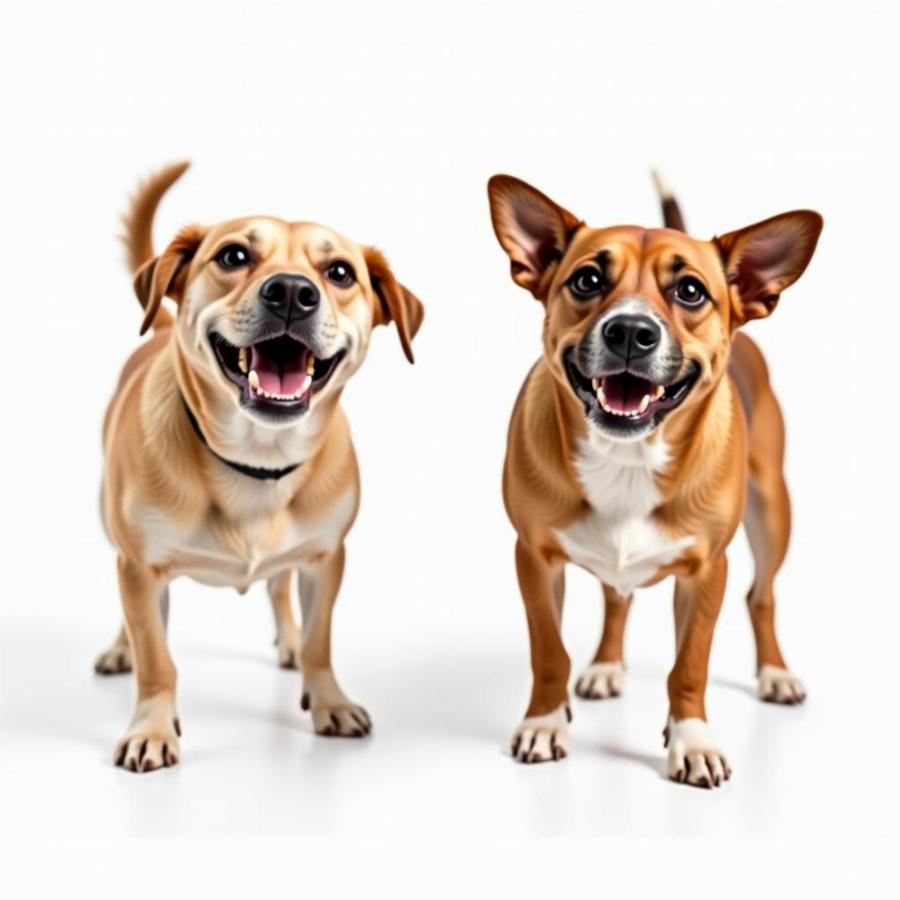Dogs with “smiling teeth” often captivate us with their seemingly joyful expressions. But what does this apparent grin really mean? Understanding canine body language, including those pearly whites, is crucial for building a strong bond and ensuring your furry friend’s well-being. While we might interpret bared teeth as a smile, it’s important to remember that dogs communicate differently than humans. This article dives deep into the nuances of canine expressions, helping you decipher what your dog is truly saying.
Decoding the Doggy Grin: Is It a Smile or Something Else?
A dog showing teeth isn’t always a sign of happiness. In fact, it can often indicate a range of emotions, from fear and anxiety to aggression and warning. Context is key. Observe the entire body language, including tail position, ear posture, and overall demeanor, to accurately interpret the “smile.” A relaxed, playful dog might show teeth accompanied by a wagging tail and soft eyes. However, a tense dog with flattened ears and a stiff body showing teeth is likely communicating discomfort or fear.
While some dogs do have a more naturally upturned mouth that gives the appearance of a smile, it’s essential to distinguish this from a submissive grin, a fear response, or even a prelude to a bite. Learning the subtle differences in these expressions can prevent misunderstandings and ensure safe interactions.
 Dog Showing Teeth: Happy vs. Scared
Dog Showing Teeth: Happy vs. Scared
Common Canine Expressions Involving Teeth
Understanding the variety of expressions involving teeth is essential for responsible dog ownership. Let’s explore some common scenarios:
- Submissive Grin: This is often accompanied by lip licking, yawning, and avoidance of eye contact. It’s a way for a dog to communicate appeasement and avoid conflict.
- Fear Grin: A fearful dog might show teeth while also exhibiting whale eyes (showing the whites of their eyes), tucked tail, and trembling.
- Offensive Aggression: This is a serious warning sign. A dog displaying offensive aggression will often have a stiff body, raised hackles, and a direct stare, with teeth bared in a snarl.
- Defensive Aggression: This occurs when a dog feels threatened and cornered. They might growl, snap, or bite to protect themselves.
What to Do When a Dog Shows Its Teeth
If you encounter a dog displaying its teeth, it’s important to react calmly and avoid escalating the situation. Here are some tips:
- Avoid Direct Eye Contact: This can be perceived as a challenge.
- Do Not Approach the Dog: Give the dog space and allow it to retreat if it feels threatened.
- Speak Softly and Reassuringly: A calm voice can help de-escalate tension.
- Do Not Make Sudden Movements: Avoid reaching out or making any gestures that could be misinterpreted as aggressive.
- Back Away Slowly: If the dog continues to display signs of aggression, slowly back away without turning your back.
Is Your Dog’s “Smile” a Cause for Concern?
While a relaxed, panting dog might show some teeth, angry dog face combined with aggressive body language should be addressed. If your dog is frequently displaying teeth in a context that suggests fear, anxiety, or aggression, consult with a certified professional dog trainer or veterinary behaviorist. They can help determine the underlying cause of the behavior and recommend appropriate interventions. Early intervention is crucial for addressing behavioral issues and ensuring both your dog’s and others’ safety.
Conclusion
Understanding the nuances of a “dog with smiling teeth” goes beyond simply seeing a cute expression. By learning to interpret canine body language accurately, we can strengthen our bonds with our furry companions and ensure their well-being. Remember, a dog showing its teeth isn’t always smiling. It’s a complex form of communication that requires careful observation and understanding. Paying attention to the entire context, including body posture and other signals, will help you decipher your dog’s true emotions and respond appropriately.
FAQs
- Do dogs actually smile like humans? While dogs can express happiness, their “smile” doesn’t necessarily equate to a human smile. It’s crucial to consider the accompanying body language.
- Should I be concerned if my dog shows its teeth while playing? If the play is relaxed and your dog is exhibiting other signs of enjoyment, like a wagging tail and soft eyes, the exposed teeth are likely a sign of playful engagement.
- How can I tell the difference between a playful grin and an aggressive display of teeth? Look at the entire body language. A playful dog will have a loose, relaxed posture, while an aggressive dog will appear tense and stiff.
- What should I do if a stray dog shows its teeth at me? Avoid eye contact, do not approach the dog, and slowly back away.
- My dog is showing its teeth more often. Should I see a vet? If your dog’s behavior changes, it’s always a good idea to consult with your veterinarian or a certified professional dog trainer to rule out any medical or behavioral issues.
Further Questions?
For more information on dog behavior and training, check out our articles on low cost dog dental las vegas.
About Beaut Dogs
Beaut Dogs is your go-to resource for all things canine, offering reliable, helpful, and in-depth information about the world of dogs. From breed characteristics to healthcare and training tips, we’re here to help you navigate the joys and responsibilities of dog ownership. When you need assistance, contact us via Email at [email protected] to get detailed and accurate answers from Beaut Dogs. Visit https://beautdogs.com today to explore the wonderful world of dogs and learn how to best care for them!